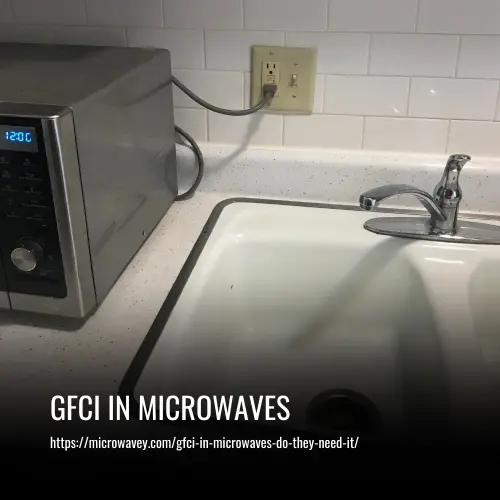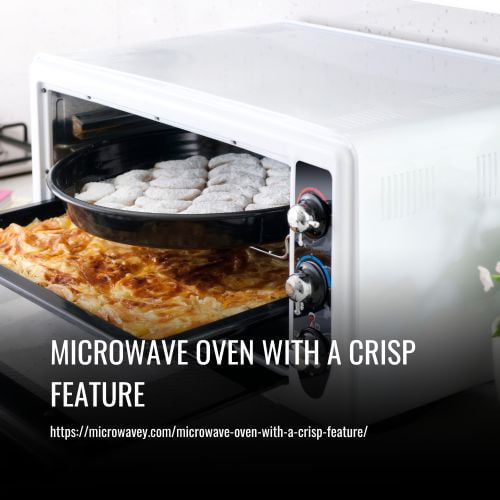GFCI in Microwaves: Do They Need it?
It is not necessary for a microwave to be plugged into a GFCI outlet in order to operate safely. However, using a GFCI outlet can provide an extra level of protection against electrical issues in the kitchen. This can be particularly helpful if there is a ground fault or other electrical problem that arises while using the microwave. It is always a good idea to follow electrical safety guidelines and consider using a GFCI outlet for added protection.

GFCI and Microwaves
GFCI requirements are based on the outlet’s location in the house and not on the appliance that it is plugged into. You will only need to plug a microwave into a GFCI outlet if that microwave is in a location that requires GFCI outlets. If your microwave is sitting on the counter it will require GFCI because countertop outlets are required to have GFCI.
Just to clarify, GFCI technology is used in the outlets and breakers, not in the microwave itself.

Where Do You Need GFCI?
GFCI is required anywhere that the outlet could potentially come into contact with water. In a home, they are required in every area of bathrooms, laundry rooms, garages, and crawl spaces. It’s also required for most outlets outdoors. For other areas in the house, it is required within 6 feet of the bowl of a sink, a tub, or a shower.
Since most people have microwaves in their kitchens, it’s important to know the rules in a kitchen. For kitchens, you must have GFCI for the outlets on the kitchen counter and anywhere within 6 feet of the sink. You do not have to have GFCI for outlets in a kitchen that are more than 6 feet away from the sink and are either well above the counter or below the counter. Usually, there is an outlet that does not have GFCI that the refrigerator/freezer can be plugged into. GFCI is not recommended for refrigerators because if it is tripped unnecessarily and you don’t notice right away it could spoil all of your food.
Why Does My Microwave Trip the GFCI
When your microwave trips the GFCI, it could be due to various reasons, including having too many appliances on one circuit, a faulty GFCI outlet, or a faulty microwave. To ensure safety and prevent hazards like electrical fires, circuit failure, and appliance damage, it’s important to address the issue promptly.
1. Too Many Appliances on One Circuit
Microwaves require a significant amount of power, and when sharing a circuit with other devices, the combined demand may exceed the circuit’s capacity. To prevent risks like electrical fires, circuit failure, and appliance damage, make sure your microwave is on a dedicated circuit without other appliances drawing power from it.
2. Faulty GFCI Outlet
If the GFCI outlet is faulty, it could cause it to trip frequently. Resetting the GFCI, testing with another outlet, and seeking professional help to evaluate the outlet can help identify and address any issues.
3. Faulty Microwave
If the microwave continues to trip the GFCI even on different circuits, the microwave itself may be the problem. Having a technician inspect the appliance for internal faults and potentially replacing it if necessary can help ensure safety and prevent electrical hazards.
Remember to prioritize safety and efficiency by promptly addressing any faults to reduce the risk of electrical shocks or accidents.
Benefits of GFCI
Most breakers and outlets are designed to protect the home’s electrical system from shorts and other damage, GFCI is specifically designed to protect the person.
We use electricity for everything we do in modern life, but even though it’s everywhere it is still extremely dangerous if you’re not careful. Accidents with electricity are responsible for around 400 deaths per year and 1000s of non-fatal electrocutions a year. GFCI helps to protect you by tripping the outlet before the fatal shock can be administered.
Having GFCI-enabled outlets can give you more confidence when using your appliances that you won’t get shocked. This is important for everyone, but especially for parents with small kids. Children are often oblivious to many of the safety tips that parents know like not sticking a metal utensil in a toaster or not using appliances that are sitting in a water puddle on the counter, or throwing a blowdryer into a tub of water. GFCI is designed to help protect against mishaps like these.
Potential Issues With GFCI Outlets
It’s important to be aware of potential issues that may arise when using GFCI outlets with microwaves. Here are some common limitations and solutions to consider:
1. False Tripping
Microwaves with high power consumption can sometimes cause GFCIs to trip falsely. To prevent this, ensure proper grounding, use quality wiring techniques, and dedicate a circuit specifically for your microwave. These steps can help minimize false tripping events and maintain harmony between your microwave and GFCI.
2. Overloading the Circuit
Overloading occurs when connected devices draw more power than the circuit breaker can handle, leading to the GFCI tripping and cutting off power. To avoid this, ensure your microwave is connected to a circuit breaker that can handle its power requirements. Additionally, avoid plugging in too many high-power devices on the same GFCI-protected circuit to maintain a balanced power load and keep the circuit breaker happy.
By addressing these limitations proactively, you can enjoy the convenience of your microwave while safeguarding against electrical hazards. Remember to also consider local building codes and their impact on GFCI requirements for added safety and compliance.
GFCI Receptacle Vs. GFCI Breaker
There are two ways to add GFCI to an outlet in your home or business. You can replace the current receptacle with a GFCI receptacle, or you can replace the breaker with a GFCI breaker.
GFCI Receptacle
You’re probably most familiar with GFCI receptacles. Those are the outlets with the two buttons on them. For most projects, the outlets are the way to go. They are cheap and fairly simple to install even if you’re not an electrician. These will offer the same protection from that outlet and can even work for other outlets down the line on the same circuit. As a side note if you ever have issues with an outlet that is close to a GFCI outlet you may want to check the GFCI to see if it was tripped.
They are also easy to access. If the outlet is ever tripped the reset button is always right there. This is especially useful if you ever have to troubleshoot one of these outlets. Sometimes they can be overly sensitive if something isn’t where it should be or if you have an older appliance, being able to turn it back on right there is a useful feature.
These receptacles will cost a consumer about $15-$25.
GFCI Breaker
A GFCI breaker is a breaker that employs the same GFCI technology as the receptacles along with the circuit overload protection that breakers are normally equipped for. This provides GFCI to all of the outlets and lights attached to that breaker. This is great if you need GFCI protection for a whole area and especially where the outlets may be difficult to reach. If you have outlets that are behind heavy furniture or perhaps a Christmas lights outlet that would be difficult to access without the ladder you may want to consider a GFCI breaker.
These are nice because you have the option of equipping all of your outlets with GFCI, but it can be more expensive than replacing the outlets. GFCI breakers can run anywhere from $50 to $100 depending on which one you need. The real problem though is that installing a breaker is much more complicated than replacing the receptacles. Unless you have electrical experience, you should be hiring an electrician to do the replacement for you and that is an added cost.
When you install a GFCI breaker you should go to all of the outlets on that circuit and label them, so that in the future if the GFCI trips you’ll know why the outlet is acting up.
If you’re just concerned about your microwave it’s probably best just to install a GFCI outlet.
How to Replace a Regular Receptacle With GFCI

Whenever you’re dealing with electrical equipment it’s usually best to call a professional electrician to do the work for you, but given that installing a GFCI outlet is fairly simple we’ll give you a brief overview of what you’ll need to replace your old regular outlets with a new GFCI outlet.
- The first step is to purchase a new GFCI receptacle. You can find these at Home Depot, Lowes, and most hardware stores. You could probably even find one at Walmart. You may also need to purchase a cover for the outlet separately so make sure you have both.
- Turn off the power at the breaker. Always do this step or you will get electrocuted when you try to change the outlet. If your breakers aren’t clearly labeled, you can plug a light into the receptacle and turn off the breakers till that one shuts off. Use a light plugged into the same outlet you’re working on, and don’t count on other items or lights in the room since those may be on a different breaker. Make sure to test the outlet before you start working to make sure there is no current.
- Remove the cover for the receptacle
- Unscrew the receptacle from the wall.
- Once you have the old receptacle out you’ll need to loosen the screws that hold down the wires. On modern 3-prong outlets, there should be three wires to remove, Generally, a black one, a white one, and an uncovered one-this is your ground wire. If black and white wires have a lot of exposed wire behind the receptacle you may want to wrap the exposed section with electrical tape after you attach them to the GFCI receptacle.
- You’ll now want to attach the wires securely to your new GFCI receptacle. Most GFCI wires allow you to insert the wires straight into the receptacle and then tighten them down with screws. If your old receptacle had the wires wrapped around the screws before clamping them down and are curled or mangled, you can trim them back a bit with some wire cutters.
- Now that the wires are attached you can screw the receptacle into the wall and then attach your cover.
- And you’re done. After turning the breaker back on you can plug your light back in and test the GFCI. When you press the test button the light should switch off, and then back on again when you press the reset button.
It is a fairly simple replacement, but if you’re inexperienced in working with electrical equipment it may still be a good idea to have an electrician do it. It’s important to always be safe when dealing with electricity.
Do I Need a GFCI for an Over-the-Range Microwave?
GFCI is not specifically required for an over-the-range microwave, but over-the-range microwaves do have specific requirements for outlets.
Microwaves draw a lot of power when they run, more than most other appliances in your kitchen. On top of that, over-the-range microwaves double as the fan and light for your stove. Most building codes require that these microwaves have their own circuit, but it doesn’t necessarily have to be a GFCI circuit.
Most likely you’ll have the outlet for the over-the-range microwave in the back of the cabinet above the microwave or at least high up on the wall next to the microwave. Since it’s not on the countertop you don’t need GFCI as long as it’s more than 6 feet away from the sink. If it’s close and you need to measure it, measure from the bowl of the sink, not the faucet.

Do I Need a GFCI for an RV Microwave?
Outlets in RVs have the same requirements for GFCI as a house. Compared to your house it is much more likely that your microwave is within 6 feet of the sink. If that is the case you will likely be required to have GFCI for your microwave.
It’s also important to note that some RVs may only have one or two circuits servicing the outlets in your RV. If the first outlet in the circuit is a GFCI outlet then that GFCI will work for the whole circuit and may trip even if the device is plugged into a regular outlet down the line.
FAQs
A GFCI, or Ground Fault Circuit Interrupter, is a safety device that helps protect against electrical shock in case of a ground fault. In a microwave, the GFCI monitors the flow of electricity and can quickly interrupt the circuit if it detects a ground fault.
A GFCI is important in a microwave because it helps prevent electrical shock in case of a ground fault. Microwaves use high voltage electricity, so having a GFCI can provide an extra layer of safety for users.
Most modern microwaves come with a built-in GFCI as a standard safety feature. You can check the specifications of your microwave or consult the manufacturer’s documentation to confirm if it has a GFCI.
It is not recommended to install a GFCI in an old microwave, as it may not be compatible with the existing electrical components. It is best to replace an old microwave with a newer model that already has a built-in GFCI.
Yes, GFCIs in microwaves may need to be reset if they are tripped due to a ground fault. Check the user manual for instructions on how to reset the GFCI.
Over time, the GFCI in a microwave may wear out and need to be replaced. It is important to regularly check the functionality of the GFCI and replace it if necessary to ensure continued safety.
Conclusion
In conclusion, having a GFCI in microwaves is a crucial safety feature that can protect you and your loved ones from potential electrical hazards. By investing in a microwave with built-in GFCI protection, you can have peace of mind knowing that you are taking an extra step to ensure the safety of your home. Remember, safety first, always!



